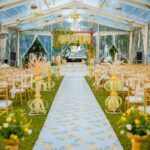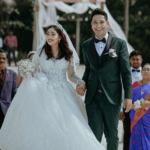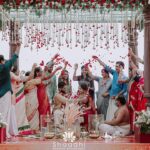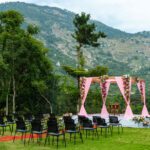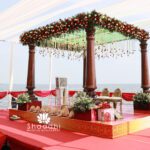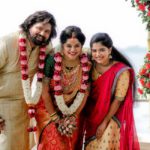PRE WEDDING CEREMONIES
FIXING THE MUHURTHAM (BY MATCHING HOROSCOPE)
The parents of the bride’s and Groom’s parents exchange horoscopes to see whether they perfectly match. Once the horoscope matches the families then choose a perfect date and time which is so called Muhurtham with the consultation of the Astrologer.
The next is the NISCHAYAM This called the Betrothal or Engagement ceremony in the other religions. This ceremony is to announce and celebrate the confirmation of the auspicious day of marriage. The horoscopes are also exchanged in this ceremony. The bride and groom exchange the rings and the families exchange gifts.
WEDDING EVE CEREMONY
Any auspicious day is incomplete without Elders blessing. This is the ceremony where the elders bless the bride at her residence it is called Ayana ( pre- nuptial blessings ) on the wedding eve. This function is celebrated and attended by the close family friend and relatives along with the authentic flavoured kerala food. The bride is draped with the saree with beautiful jewelleries and made to sit facing towards the east and the elders bless the bride. Similarly the same custom is followed in the Groom’s residence.
After this the Bride’s aunt put the mehendi in the Bride’s hand as one of the common tradition in Hindu religion. This ceremony is called the Mehendi ceremony.
WEDDING DAY & RITUALS
The wedding is usually conducted in the Bride’s Ancestral House, those are the past. Now the trend is to conduct these Rituals either in Convention center, Auditorium or in the temple depending on the number of guests invited.
Normally, a Nair wedding is conducted by the elders from NSS (NAIR SERVICE SOCEITY) that is called Karayogam.There will be two karayogams involved,one that of the boy and the other ,the girl.The Rituals of garlanding, tying the mangalsuthra, handing over the pudava etc varies from place to place.
The next Ritual is Dakshina koddukal. Both Bride & Groom perform this Ritual in their respective house. The bride & groom go to the elders receive their blessings by giving “Dakshina” and touching their feet.
SACRED ITEMS ARRANGEMENTS ON THE MANDAP
The Nair follow a strict custom of placing their sacred object on mandap.Nilavilaku (Traditional lamp) ,Nellu (paddy) ,Nirapara ,Pookula (coconut flower),Astamangalyam, Thalam (includes arecanut flower,small para, small vilaku,kasavu visari cloth ).
Ashta ( Eight) Mangalyam( Marriage or other occasion) consist of Eight articles that is kept on a large metal plate or bronze vessel for offering . These eight article can be replaced in four different ways:
(a) Rice, paddy, tailed mirror, sandal, reddish kumkum, kajal, grandh (holy book) and washed clean cloth.
(b) Nira( paddy), Nazhi ( Rice ), mirror, flower, vessel, villakku (small holy lamp), adorned girl, gold.
(c) Paddy, Rice, Beetel Wine, Areca nut, coconut, Jaggery, Banana & villakku(small holy lamp )
(d) Nira para, villakku, mirror, gold, coconut, curd, book & cheppu ( small pot).
WEDDING CEREMONIES
WELCOMING GROOM & FAMILY
The groom and his family members and friends arrive at the wedding venue, they are given a grand and warm welcome by the family members of the bride. Traditional music in the form of thakil and nadaswaram are played during this time. Traditional brass lamps are lit and the groom and his family are welcomed. The feet of the groom are washed by the bride’s brother and then there is a Ritual of aarthi of the groom by female relatives of the bride. The groom is then escorted in a ceremonious way to the kalyana mandap by the cousins and siblings of the bride carrying thalams. The groom entered the stage ,then greet the guests and sit on a wooden plank in the right side of the madap and he has to face towards east.
BRIDE ENTRY
The bride is brought into the mandap accompanied by the girls with thalam, astamangalyam and nadaswaram by holding the hand of father or maternal uncle or father’s brother .She is made to sit on the left of the groom.
THALIKETTU
At the muhurtam time (referred by astrologist ), the groom’s father gives him the “thali” (mangalsuthra) which he ties around bride’s neck.Then the groom ties the sacred ‘thali’ around the neck of the bride. Thakil and nadaswaram are played when the groom ties the holy yellow thread.This Ritual is called “Thalikettu”. After that the groom put a bit kumkum/sindoor at the center forehead of the bride. An icon like this can see in every hindu married woman. It’s belief of trust between the partners.
EXCHANGE OF GARLANDS
After Thalikettu,next is the exchange of garlands and bouquets. As per the Nair traditions, the garland supplied by the bride team.
PUDAMURI
The bridegroom gifts the bride a sari and a blouse on a platter, conveying to her that he will now assume the responsibility of providing for her life. This Ritual is called “Pudamuri.”
KANYADAN
The bride’s father places the bride right hand over groom’s right hand, signifying that he is handing his daughter to the groom in holy matrimony. This is the ‘kanyadaan’ Ritual and is an emotional moment for the bride and her father. Holding hands, the couple goes around the sacred mandap three times. This is the end of the main marriage ceremony.
SADHYA
Once this ceremony is over, the couple is taken to a separate room where they receive blessings and gifts from their elders and friends. This is followed by the grand meal, also known as sadhya. The meal consists of 25 items and is served on a plaintain leaf. The items include rice, three kinds of pickles, olan, pachadi, avail, kalam, curries and sweets, pappads, toran, payasam and chaka prathaman or paladaaprathaman. All the items are traditional vegetarian dishes.
A typical meal in Kerala Nair weddings is the sadhya. Sadhya consists of 25 items, served on plantain leaves. Rice, three varieties of pickle, curries and sweets, avial, toran, olan, kalam, pacchari, payasam, pappads and finally, the desert – paladaa prathaman or chaka prathaman, are a part of the elaborate meal.
POST WEDDING RITUALS
Kerala Nair wedding does not get over with the wedding ceremony and the gala feast. There are some post wedding Rituals as well that take place.
Grihapravesham – At the perfect auspicious moment, the groom takes the bride to his home. Some family members of the groom are also present. On reaching home, the bride holds a traditional brass lamp in her hand and walks into the house putting her right foot in first. The whole house is lit with lamps so that it looks bright. The Ritual is known as kudivep. Then her in-laws shower her with gifts like clothes, jewellery and other ornaments.
Wedding attire and jewellery – integral part of the marriage
After taking a detailed look into the Rituals of Kerala Nair marriage, it is now time to take a look at the wedding attire of the bride and the groom for the most auspicious ceremony of their lives. The groom has to wear a white silk dhoti with golden border and an Angavastram that covers his body. Wearing a gold chain and gold bracelet is mandatory for the groom. Rings are also worn on the fingers. This completes the wedding attire of the groom.
The bride is the one who is decked up grandly for her wedding day. She wears a white silk saree with golden border. She is decked up in jewellery from head to toe. If you take a look at a traditional Kerala Nair bride, you will be surprised to see that great volume of gold that she wears for the special occasion. A Nair girl’s jewellery box is called as Aamaadapetti. If you take a look at the aamaadapetti of a Nair bride, you are sure to find some of the finest jewelleries for all parts of the body. There are innumerable kinds of ornaments for the neck and are known by different names like Minnum Maniyum, Naagapadam, Naalupanti, Mullamottu Mala, Addiyaal, Jnali Kuzhal, Kantasaaram, Maanga Mala, Ponnu-Nool, Arimbu Mani, Padakka Thali, Rasi Thali, Kasu Mala, Elekka Thali etc.
Along with the neck ornaments, the bangles also need special mention. The Simha Kada, Ashtalakshmi Vala and Kattikappu are commonly worn by the bride. Oddiyanam, the wait ornament is also very special for the occasion. Rings as well as studs can be worn for the nose and they are known as Mookuthis. These were mainly of diamonds or ruby. Padaswaram or Thala are worn on the ankles as it makes a sweet sound when the bride walks. Earrings worn are also heavy and sometimes they have extensions to the whole ear lobe and called Toda. Jhimiki is placed between the hair partings and comes on the forehead. Fingers are adorned with heavily embellished and stone encrusted rings called Pavithrakkettu. Along with use of heavy gold, the jewelleries have the best of diamonds, rubies, pearls, emeralds and other precious and semi-precious stones to enhance their beauty.
